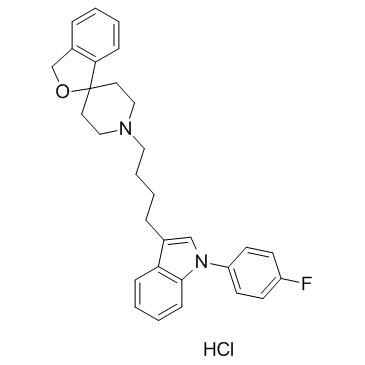224177-60-0
| Name | 1'-[4-[1-(4-fluorophenyl)-1H-indole-3-yl]-1-butyl]-spiro[isobenzofuran-1(3H),4'-piperidine], hydrochloride |
|---|---|
| Synonyms |
Spiro[isobenzofuran-1(3H),4'-piperidine], 1'-[4-[1-(4-fluorophenyl)-1H-indol-3-yl]butyl]-, hydrochloride (1:1)
1'-{4-[1-(4-Fluorophenyl)-1H-indol-3-yl]butyl}-3H-spiro[2-benzofuran-1,4'-piperidine] hydrochloride (1:1) Siramesine (hydrochloride) |
| Description | Siramesine(Lu 28-179) Hcl is a selective sigma-2 receptor agonist, which has been shown to trigger cell death of cancer cells and to exhibit a potent anticancer activity in vivo. IC50 value:Target: sigma-2 receptor; lysosome-destabilizing agentsiramesine can induce rapid cell death in a number of cell lines at concentrations above 20 μM. In HaCaT cells, cell death was accompanied by caspase activation, rapid loss of mitochondrial membrane potential (MMP), cytochrome c release, cardiolipin peroxidation and typical apoptotic morphology, whereas in U-87MG cells most apoptotic hallmarks were not notable, although MMP was rapidly lost [1]. Siramesine, a sigma-2 receptor agonist originally developed as an anti-depressant, can induce cell death in transformed cells through a mechanism involving lysosomal destabilization [2].in vivo: SA4503 or siramesine given jointly with MEM (as well as with AMA) decreased the immobility time in rats. The effect of SA4503 and AMA co-administration was antagonized by progesterone, a sigma1 receptor antagonistic neurosteroid. Combined treatment with siramesine and AMA was modified by neither progesterone nor BD1047 (a novel sigma antagonist with preferential affinity for sigma1 sites) [3] |
|---|---|
| Related Catalog | |
| References |
| Melting Point | 225 °C |
|---|---|
| Molecular Formula | C30H32ClFN2O |
| Molecular Weight | 491.039 |
| Exact Mass | 490.218719 |
| PSA | 17.40000 |
| LogP | 7.35370 |
| Hazard Codes | Xi |
|---|
